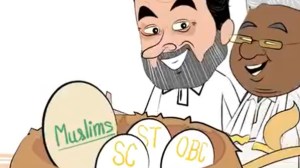- India
- International
It’s like killing a child
Goa government offers a half-baked explanation for the removal of the coconut tree from the ambit of the Preservation of Trees Act.
 Figures show that in any given year, some 40-50 coconut trees were allowed to be felled under the act.
Figures show that in any given year, some 40-50 coconut trees were allowed to be felled under the act.
There are not that many ways to stun the world, but the Goa government succeeded in doing precisely that last week. To the consternation of all those who have visited this tourist destination crammed with no less than four million coconut palms, the Goa government amended the Goa Preservation of Trees Act to remove the coconut tree from its ambit, arguing that the coconut tree was an imposter; when seen in its true colours, the tree displayed, for example, no branches at all and, therefore, failed the botanical test: At most, it could be called a shrub, a grass or even a mop, but sorry, no longer a tree.
The decision now enables anyone in Goa to fell coconut trees without a permit.
However, public response in Goa has been instantaneous, accompanied by shrill denunciation, derision, lampoons, angry satire, cartoons, public demonstrations, videos, songs and slurs. This is the sort of response you get when you perceive someone has approached you with an indecent proposal.
Goans have had a love affair with coconut trees that predates the Portuguese incursion of 1510. So the issue of felling them freely simply does not arise. They plant them in profusion. They look after them affectionately and also fight over them.
 (Illustration by: C R Sasikumar)
(Illustration by: C R Sasikumar)
The coconut tree is a constant source of tort: If it grows erect, there is no breaking news. Trouble begins when it begins to lean, as all tall things eventually do. While the roots remain in one property, the
nuts and dried fronds fall on the roofs of neighbours, breaking tiles or heads. Civil disputes are legion. Some have reached the high court.

In a recent case, a high court bench, in complete complicity with local sentiment, ruled that the government had no justification to cut all five problem trees belonging to the petitioner, only two would do.
The judge, a well-known Goan, could not fathom why anyone would want to cut five coconut trees in one fell operation. It’s just not done. And certainly, no such proposal would get endorsement from a constitutional court.
It is difficult to explain why the prospect of having to cut a mature, bearing coconut tree can make even grown Goans cry. It’s like killing your own child. A coconut tree produces nuts within eight to 10 years, after which, for the rest of its life, it simply gives, gives and gives. When it dies, its trunk is splintered into rafters and used to hold up the roof.
The coconut is the principal ingredient in fish curry and rice, the recipe that has now made it to menus across the world, from Mumbai to Dubai, as “Goan curry”. Its leaves are elegantly woven into large partitions for protection during the monsoon and for pandals. From the coconut come a bewildering variety of products: Coconut oil, fibre for ropes, shells for fuel. This is a kalpavriksha, true to type: Nothing is wasted; nothing can be wasted.
Everything about the tree demands specialised expertise. Few human beings can climb one. Those who can, do it so effortlessly they get into picture postcards. De-husking the coconut looks a formidable expedition, but all along the coast, housewives can do one-a-minute. Felling a coconut tree needs a pro. It is cut and lowered in sections, but not without an attendant gaggle of spectators providing continuous gratuitous advice; anyone doing it any other way would almost certainly wreck a couple of houses in the vicinity. Every monsoon, we lose two to three days of power because some old coconut tree has decided to give up the ghost and taken all the overhead electrical wires with it.
No advertisement of the Goa government promoting tourism appears without a coconut tree. The sands of Goa would be unbearable to tread without the thousands of these palms, swaying elegantly in the wind, providing the necessary shade.
So what brought on the government’s hostility to this humble tree? What reasonable explanation is there for this perfidy that Goan citizens see as an act of treason?
The government’s defence is that including it in the act (which covers all trees, including coconut palms) was originally an error. As a result, people wishing to fell diseased or affected trees were required to run the gauntlet of the cumbersome procedures of the act. The new amendment merely allows such trees to be removed without a permit.
This is a half-baked justification. The Preservation of Trees Act allows emergency felling. One only needs to inform the forest department of any such felling in 24 hours. I have used this provision myself for removing a mango tree that started to lean towards the roof of my house in the monsoons. There are also other provisions for more chronic cases.
Available figures show that in any given year, some 40-50 coconut trees were allowed to be felled under the act. One, therefore, does not amend an act in such draconian measure if it involves such small numbers.
For Goans, the coconut tree will always remain more than just a tree. The government of Goa, on the other hand, has only a different vision of Goa, one which requires its complete remaking.
This tawdry vision has brought in many unwanted suitors: A needless new airport, a golf course, a new liquor factory, the Defexpo, marinas, real estate, expanded roads. All need the mass slaughter of coconut trees.
The Preservation of Trees Act does not permit the removal of trees on more than one hectare at a time. The coconut and the cashew, both the unmistakable face of Goa, stand in the way. Like several other features of Goan life, including perhaps Goans themselves.
40 Years Ago
EXPRESS OPINION
More Explained
May 07: Latest News
- 01
- 02
- 03
- 04
- 05








































